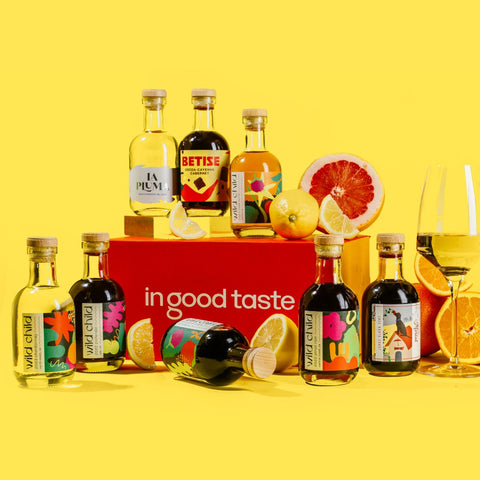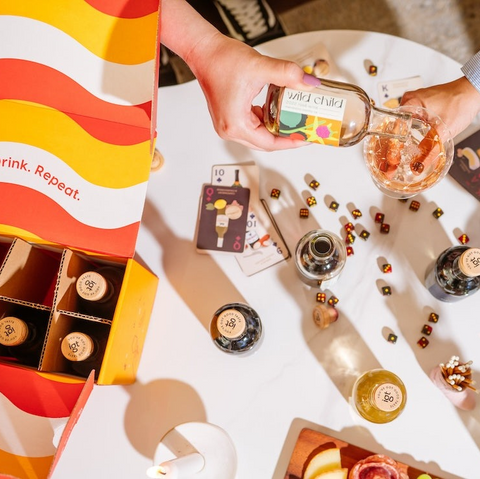Your Gateway to Wines from the South Pacific
Welcome to the delicious world of Wines from Down Under. While Australia and New Zealand are relative newcomers to the international wine scene, both countries hold their own on the premium wine playing field. As New World wine regions, the two countries aren’t beholden to the hundreds of years of tradition of Old World wine regions, allowing them to experiment; push boundaries; and, ultimately, revolutionize the way the world views, produces, styles, and packages wine. From rich, smooth Barossa Shiraz to mouth-puckering Marlborough Sauvignon Blanc, Australia and New Zealand are two wine-producing countries to watch.

In the late 1990s, New Zealand launched a major initiative to move all bottles from cork to screw top. This happened for three reasons: most importantly, to avoid 2,4,6-trichloroanisole (or TCA) contamination. TCA is a chemical compound that is the leading cause of cork taint, brought on when naturally occurring, airborne bacteria or fungi come in contact with chlorinated phenolic compounds. In short, the presence of TCA and cork taint causes the wine to spoil and smell like wet cardboard. Although the percentage of bottles affected by TCA is relatively small, it can be devastating to boutique wine brands that do not produce in large quantities. This switch to screw cap also helps to preserve the fresh, fruit-forward flavors that white wines in New Zealand are known for as well as to clearly distinguish the New Zealand wine style and culture from “old world” European culture. Australian wines soon followed New Zealand with the screw top trend, and now, a high percentage of Aussie wine is also closed with a screw top. These countries in the Southern Pacific region take pride in their unique style of wines and take risks to break free from European traditions and rituals in winemaking.

A Brief History of Australian Winemaking
All the Koalifications
Australia’s wine history dates back to 1788, when settlers from South Africa brought over rootstock to plant the first grapevines. In the mid-1800s, French immigrants arrived in Australia, bringing with them their own cuttings, knowledge, and improved winemaking techniques.
However, wine in Australia didn’t really catch on with the local population for some time. By the mid-1960s, domestic annual consumption was estimated to be just over two bottles per person. Australians preferred a sweeter sip: 80% of wines consumed at the time were fortified wines, like Sherry or Port.
Thankfully, styles and tastes changed with time, and by the 1980s, the Australian wine industry exploded in production, exportation, and international (as well as local) consumption. With Australian wine’s new popularity came exploration into new varietals and techniques. By 1996, local consumption increased to an estimated 24 bottles per person, and 80% of wines consumed were table wines. Australia has since become the sixth top wine producer in the world, producing nearly 12 million hectoliters (or roughly 317 million gallons) of wine in 2019.

Top Wine Varietals & Regions from Australia
Australia is a massive and diverse wine region, with over 100 grape varieties and 65 distinct wine regions. Geographically, it is split into five major wine-growing regions: New South Wales, Victoria, Tasmania, and parts of Queensland and South Australia. Yet most of the country’s wine grapes are grown in its southeast regions, the north being too tropical and the center being too dry and hot. Alone, the state of South Australia produces more than half of the country’s wine. It is the driest state in Australia, which is the driest continent in the world.
Australia is mainly known for its Shiraz, or Aussiefied Syrah, and Chardonnay varietals. In fact, these two varieties alone account for 44% of its total wine production! Ever open to new challenges, this region is diversifying rapidly as growers are replanting many vineyards with Cabernet Sauvignon, Sauvignon Blanc, and Pinot Noir.
“I worked in Australia for the 2004 harvest at Mitchelton Wines in Victoria. This was an incredible experience, not just for the friendships I made, but also for the diversity of wines that I helped to craft,” says In Good Taste Head Winemaker, Matt Smith. “I loved working with Shiraz (new for me – I was a Pinot guy) and the other Rhȏne varietals from the Estate, Cabernet from Coonawarra and Heathcote. Some of the greatest wines I’ve experienced were all there, ‘Down Under.’”

The Barossa Valley in South Australia, with its Mediterranean-esque climate, dry summer weather, and overall very low rainfall, is ideal for shiraz. The soil here is dark red and brown, and is made up of alluvial, loam, clay, and schist soil types, which hold heat and ease the ripening of wine grapes. The vines in Barossa are unique in that they are very old and located in a region so far protected from the vine-killing pest phylloxera. Shiraz wines produced in this region are big, bold, and full-bodied, with rich texture and concentrated fruit. While shiraz accounts for over 51% of all the grapevines planted in the Barossa Valley, it’s worth noting that grenache and other red grape varietals are also grown here.
If you drive about one hour south of Barossa, still in the South Australia region, you will reach Adelaide, a region producing world-class Pinot Noir. This grape thrives well in the sloping topography and cool climate.
The cool climate of Clare Valley in South Australia is perfect for Australia’s world-class Riesling grapes. The crisp and pure air deters one of wine’s biggest foes – an anamorphic fungus known as botrytis – resulting in clean, fresh, limey fruit. And cooler nights in the Clare Valley ensure that these Rieslings have high acidity and a dry finish.
For still and sparkling wines, we reach another cool and dry climate on the island of Tasmania, just south of Australia’s mainland. Chardonnay and Pinot Noir are the two most-planted grapes in this region; however only one percent of Australian wines originate in Tasmania, and due to the overwhelming demand and high quality, the price of wines coming out of this region are relatively high.

A Brief History of New Zealand Wines
Kicking it Down to Kiwi Land
They say that good things come in small packages, and this is especially true of the tiny wine region of New Zealand. The North and South Islands of New Zealand have 11 wine regions, totaling just over 700 miles. The wine regions on North Island include Northland, Auckland, Waikato, Gisborne, Hawkes Bay, and Wairarapa. South Island boasts Nelson, Marlborough, Canterbury, and Central Otago, the southernmost wine region in the entire world!
The history of winemaking in New Zealand dates back to 1851, when the first grapevines were planted; however some of the more recently popular regions, like Martinborough, have only 30 years in the winemaking industry. In such a short amount of time, the innovation of New Zealand wineries have made a substantial impact on the wine industry and has made its mark to become one of the world’s most popular wine-producing regions.
“I spent an incredible two weeks exploring the South Island of New Zealand. Visiting a wonderful friend and winemaker there in Marlborough, I had access to some of the greatest wines in the region,” reminisces Matt Smith. “These wines truly express a sense of place. I returned to California with an appreciation for the incredible wealth and variety of great wines ‘Down Under’ and an understanding that the best wines perfectly express their origin!”
Notable New Zealand Wines
In all, 80% of wines grown and produced in New Zealand are white wines, and the country’s flagship varietal is its Sauvignon Blanc from the Marlborough region, affectionately called a “Kiwi wine icon.” Sauvignon Blanc from Marlborough is typically high in acidity and herbaceous, with heavy aromas of fresh-cut grass and citrus aromas like grapefruit making it easy to identify in most blind tastings. “The Kiwi terroir leaves an indelible trace on their wines that is unmistakable. Green, grassy and green pepper characters are New Zealand’s signature. At their most intense, they resemble jalapeno pepper and boxwood,” explains Smith.
Hawkes Bay, the second-largest wine region in New Zealand, found on the North Island, is known for producing world-class Sauvignon Blanc and Syrah. The Sauvignon Blanc from Hawkes Bay is closer to an old-world Bordeaux style, with softer acidity than the fruit-forward Marlborough style. Syrah from Hawkes Bay is loved for its elegance and rich, dark, plum flavors. Hawkes Bay has long sunny days that add to the development of aromas and flavors in Syrah; the cool nights maintain the freshness of the grapes, making for very unique-tasting Syrahs.
The maritime climate in New Zealand lends a strong ocean influence as no wine region is more than 80 miles from the ocean. Ocean breezes bring long, hot days and cool nights to this New World wine region of the Southern Hemisphere.
Wines from Down Under
Whether you are drinking wine from the big island of Australia or the tiny islands of New Zealand, the wines from Down Under are clearly creating a beautiful legacy in the world’s wine culture. When you think of “New World” wine, these two countries are in the top five regions to watch as they continue making a name for themselves with experimental techniques, biodynamic farming methods, and distinct tastes that reflect the unique terroir of the South Pacific. From the grassy notes of New Zealand’s Marlborough Sauvignon Blanc to the bold peppery flavors of Australia's Barossa Valley Shiraz, and every wine region in between, the Australasian winemakers are sharing their story with the world one glass at a time.









